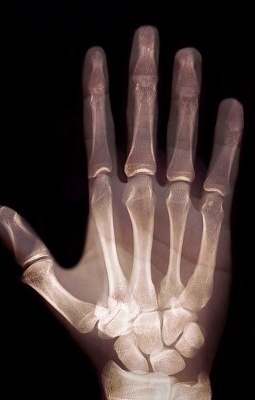How Do X-Rays Work?
An X-ray is an electromagnetic wave that has a shorter wavelength than visible light and is created when an electrical current passes through an x-ray tube. When the current passes through the tube, the resulting radiation beam is an x-ray. This beam can penetrate objects or materials that consist of light atoms, but objects made of heavy atoms will absorb it. This quality makes X-rays useful for detecting bone fractures and for studying the structure of materials.
When were X-Rays Discovered?
German physicist Wilhelm Roentgen was the first scientist to be given credit for the discovery of X-rays in 1895. Researcher A.W. Goodspeed made the first discovery of the rays in February of 1890. However, he did not take credit for his discovery since he thought it was an accident. In Goodspeed’s experiment, he placed a glass tube with wire running inside of it in a black paper box. It was then connected to an induction coil, which passed an electric current into the tube. After the current flow was initiated, a green light appeared in the room. As he continued to experiment with the phenomenon, Goodspeed found that the light could penetrate wood and metal. He ultimately found that when he placed his hand in front of the light, he could see the outline of his bones on a screen behind his hand, which became known as the first “X-ray” image.
to an induction coil, which passed an electric current into the tube. After the current flow was initiated, a green light appeared in the room. As he continued to experiment with the phenomenon, Goodspeed found that the light could penetrate wood and metal. He ultimately found that when he placed his hand in front of the light, he could see the outline of his bones on a screen behind his hand, which became known as the first “X-ray” image.
How are X Rays Produced?
The simplest way to produce x-rays is to send a beam of high energy electrons toward a sheet or piece of metal (tungsten is typically used). The metal then reflects a beam of x-rays back in the direction of the original high energy beam. The higher the voltage used in the generating beam, the greater the frequency of the x-rays that will be produced.
What are the uses of X-rays?
Since their original discovery, x-rays have been used for a number of purposes. Most consumers are familiar with a doctor using them to check whether a bone is broken or for the dentist to check for cavities. X-rays are also used in security applications to check for illicit materials or weapons on travelers and in luggage. X-rays are also used in various industries to check for metal fatigue and cracks in equipment in order to detect components that require replacement prior to experiencing catastrophic failure. X-ray beams have also been used to verify the authenticity of oil paintings. In the research industry, x-rays have been used to help create micro-circuit design patterns and to conduct x-ray crystallography. Finally, those in the astronomy field use the x-ray to help study other x-ray patterns passing through space to learn about the formation of celestial bodies.


Comments - No Responses to “How Do X-Rays Work?”
Sorry but comments are closed at this time.